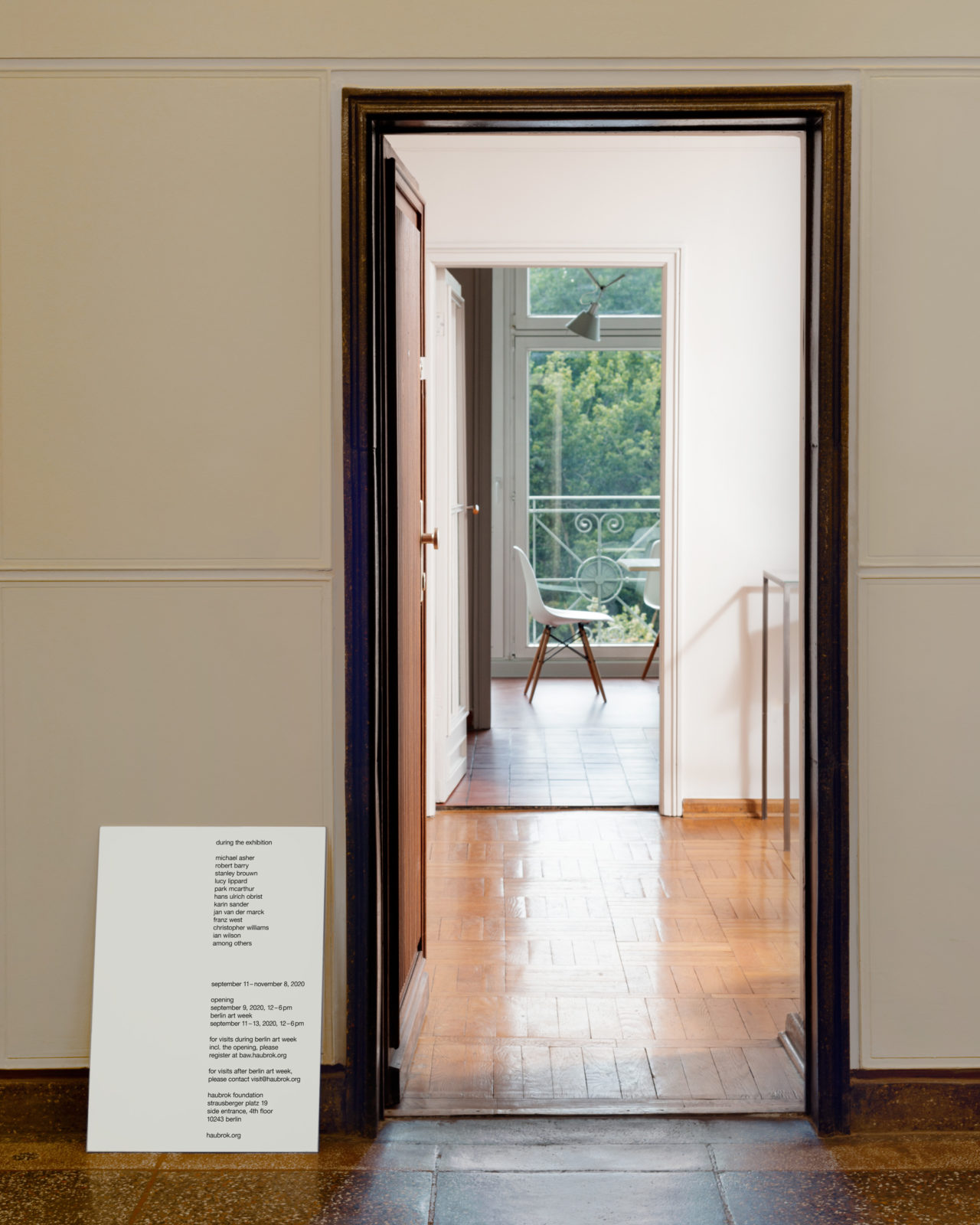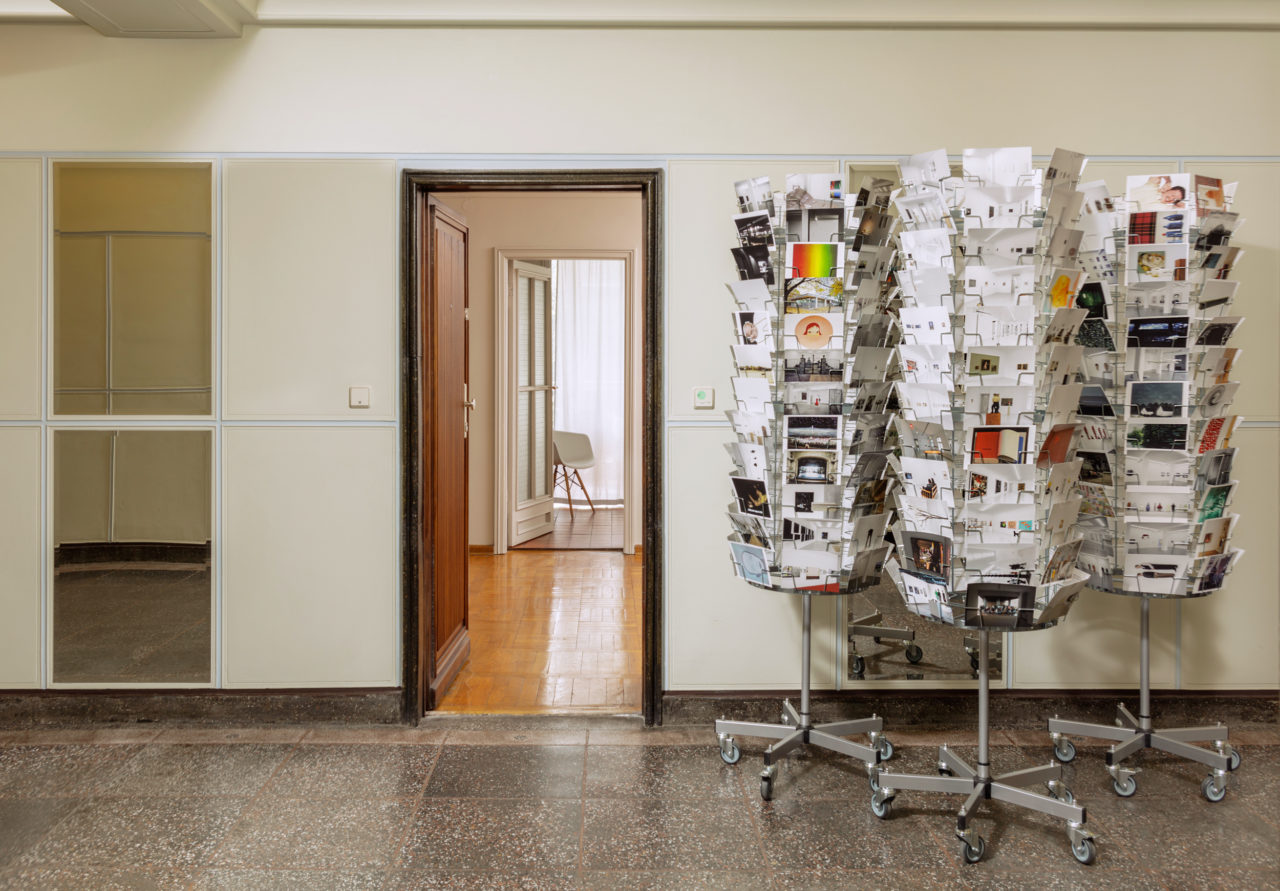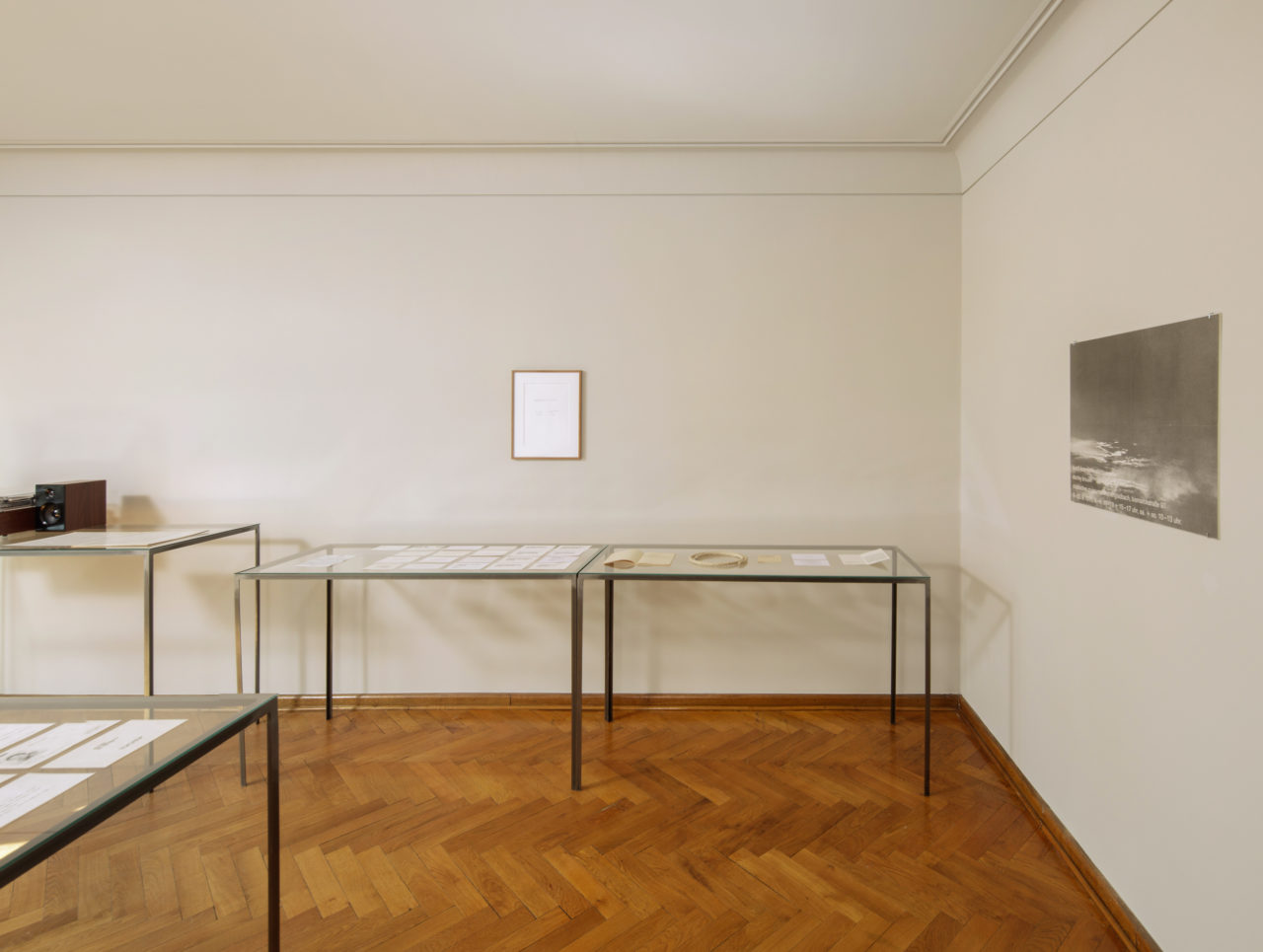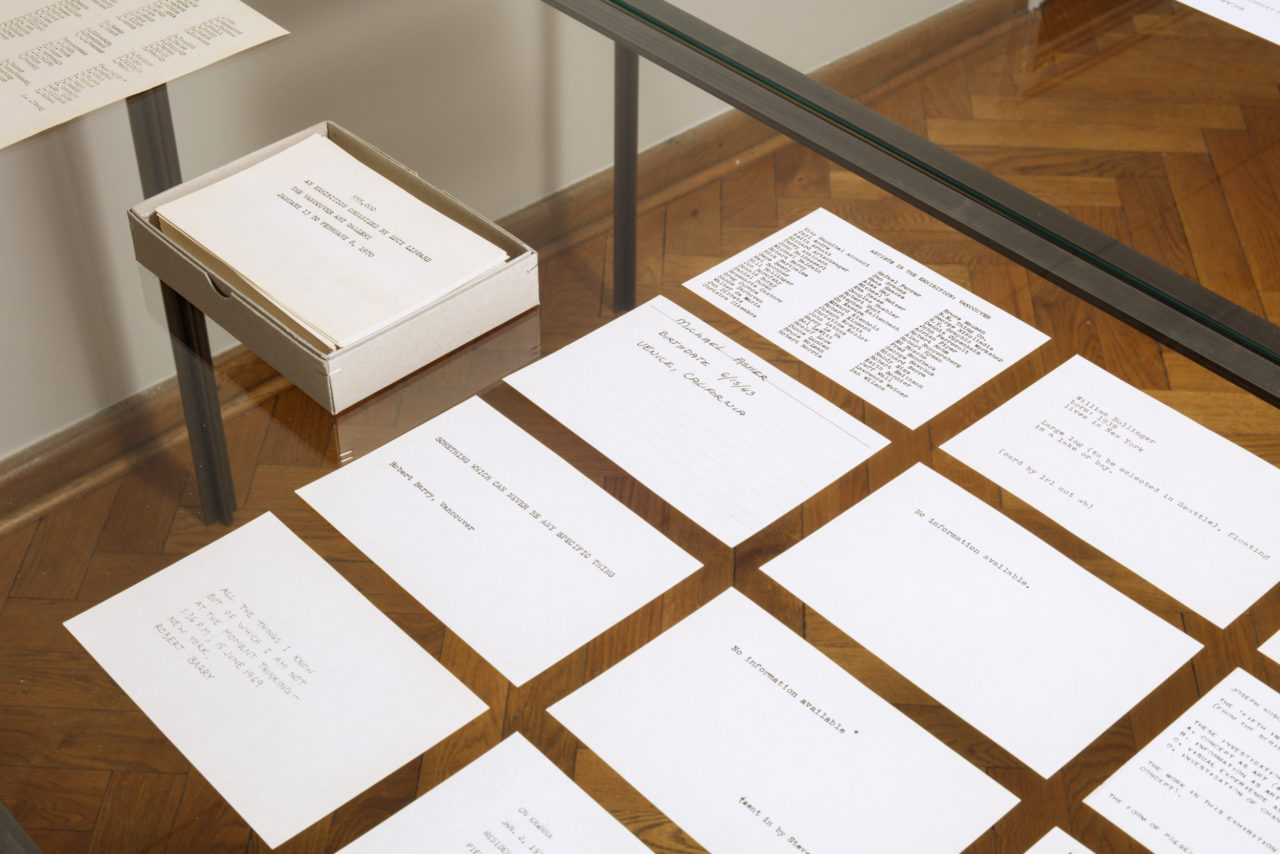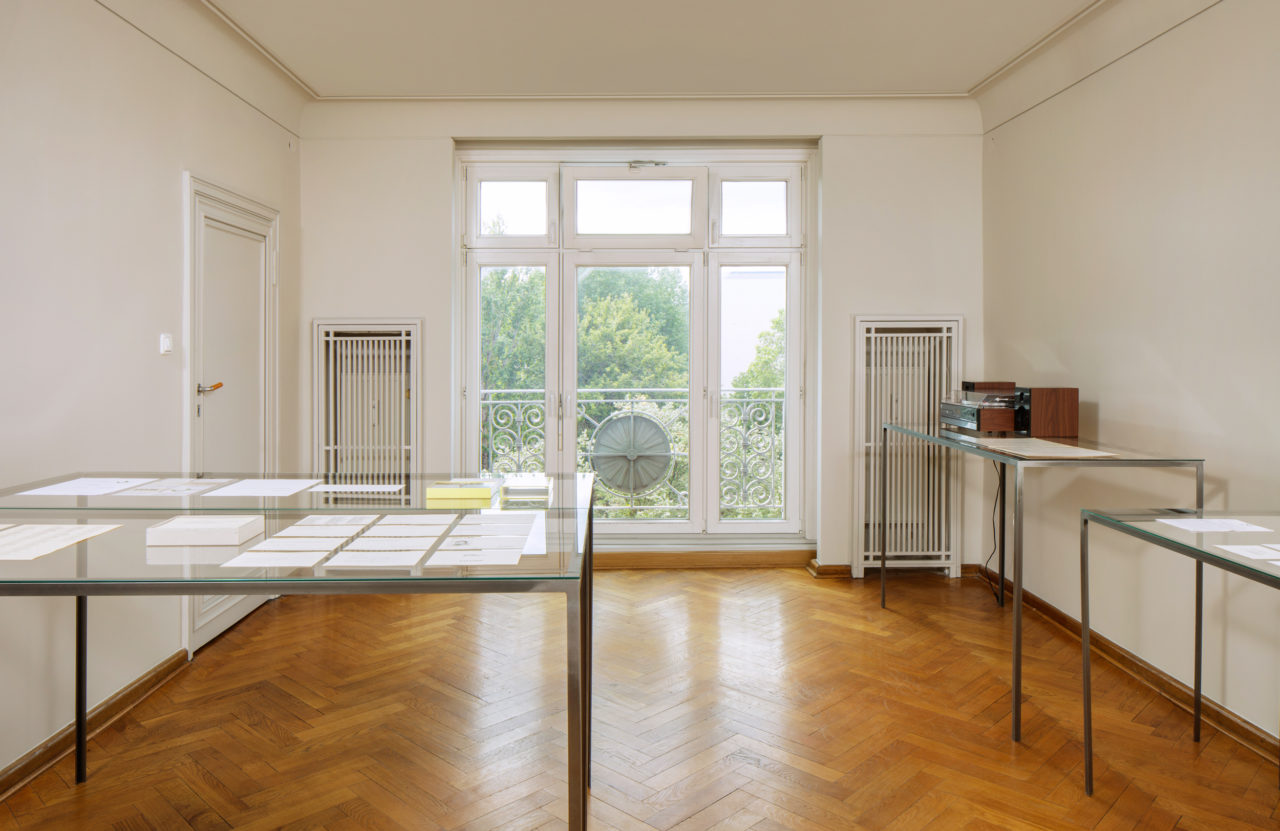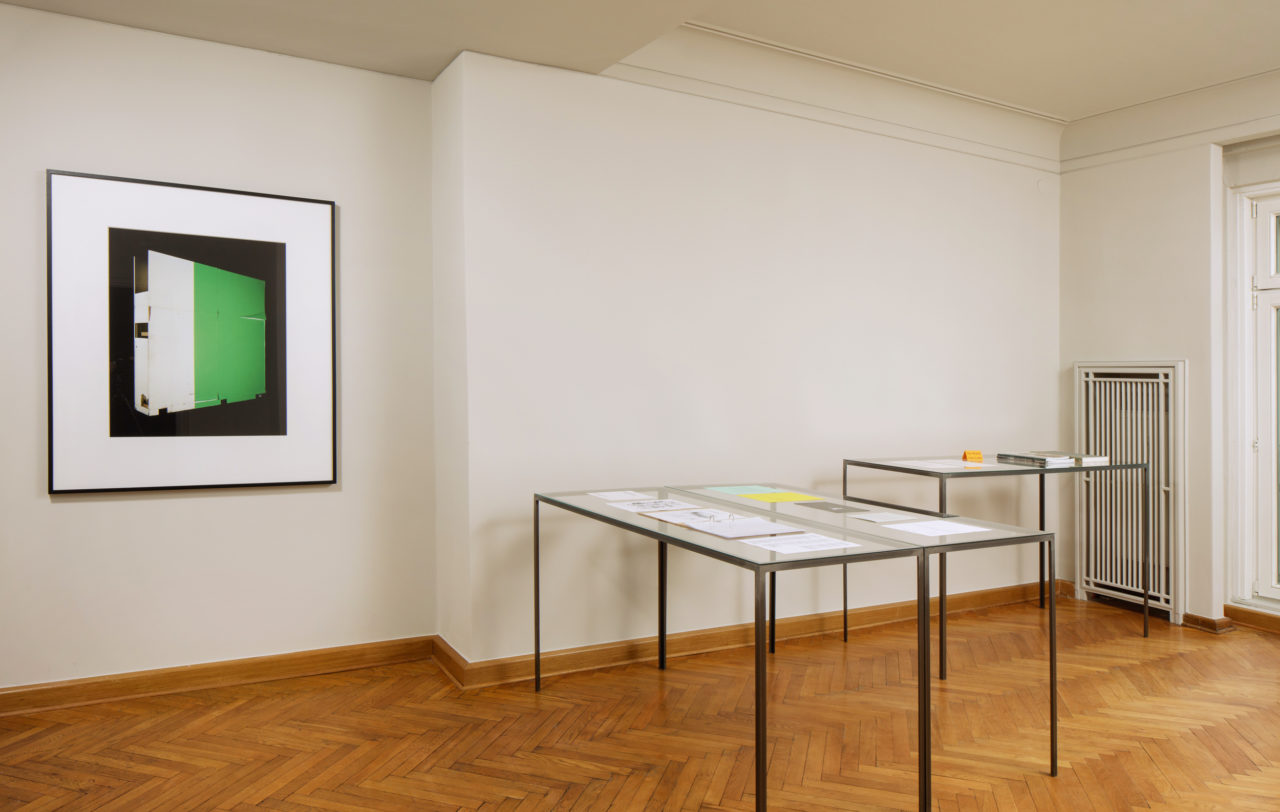For Berlin Art Week, the haubrok foundation officially opens its new rooms at Strausberger Platz 19 — 2 floors above the space in which we have already held more than 25 exhibitions between 2007 and 2013. The new rooms, a former apartment more or less in its original historical condition, are primarily intended for the presentation of small-format, ephemeral, and conceptual works.
The first project, curated by Konstantin and Axel Haubrok, is during the exhibition, an exhibition about conceptual exhibition approaches. These originate primarily from the sixties and seventies, when many conceptual artists critically examined the framework conditions of exhibitions — a discourse that is still valid today.
In during the exhibition, there are less actual works of art to be seen, but rather a whole series of invitation cards, posters, publications, and other ephemera, which document the attitude and corresponding conceptual exhibition activity.
In the hall in front of the actual exhibition space there are three stands filled with postcards. The cards document all exhibitions that Jörg Johnen has held in his former gallery. At the end of his exhibition activity, the artist Karin Sander documented the entire history of Galerie Johnen through her installation and titled it exhibition record (2016), a reference to the amount of exhibitions.
In the entrance area of the apartment, there are several works by the US-American conceptual artist Robert Barry. These include the titling work Closed gallery (1969) with the beautiful text “during the exhibition the gallery will be closed” — Barry had several exhibitions in the late sixties that were not open to the public. Another work by Barry in the same room is his Invitation piece (1972 – 1973). Here the galleries involved did not invite visitors to their upcoming Robert Barry exhibition but to the following one with the next gallery in line.
In the right-hand exhibition space on the left side, there are two vitrine tables which deal with different presentation formats of exhibitions. Barbara Schmidt Heins shows with her so far unrealized Konzept für ein Buch als Ausstellungsort (1978) the possibility of an exhibition in book form, while Lucy Lippard carried out her exhibition 955,000 (1970) completely in the form of postcards and thus documented the structures behind the exhibition in a very profane way.
Another example of an exhibition in postcard form is Hôtel Carlton Palace Chambre 763 (1993) by Hans Ulrich Obrist. Obrist had invited a large number of artists to design postcards for him. He exhibited them in the room 763 in question. Visitors were not allowed, the documentation is the reproduced cards.
Ricardo Valentim goes one step further with An exhibition in a business card page (2017). His exhibition consists of an A4 clear sleeve with a total of twelve business cards (designed by artists such as Ana Jotta, Sol LeWitt, and David Horvitz). The documentation of the exhibition, including the invitation card, press release, and list of works, takes up considerably more space than the works in the exhibition itself.
The left table on the opposite wall documents an exhibition from 1969, which was curated exclusively by telephone. It is an irony of fate that this exhibition could not take place after all, despite the considerable effort involved (Art by telephone, 1969).
On the table next to it we show invitation cards to discussions with Ian Wilson. In 1969, Wilson had decided not to create any more physical works of art and instead to conduct exclusively discussions. One of these discussions took place at the opening of the FAHRBEREITSCHAFT in Berlin-Lichtenberg (There was a discussion, in Berlin, on the 28th of April, 2013., 2013).
In the small book to the right, David Lamelas asks the question of the oral and written word as an art form. Ian Wilson’s contribution to this publication: an empty page (Publication, 1997).
During an exhibition in Eindhoven, surinamese conceptual artist Stanley Brouwn, who throughout his life had worked with various historical measurements, made sure that local historical measures were used instead of the usual metric ones in an Eindhoven household goods store when selling goods. The rope on the right vitrine table, which corresponds in length to a historical Eindhoven foot (One Eindhoven foot of rope, 2005), bears witness to this.
Next to it is, among other things, the invitation card to an exhibition by Stanley Brouwn, which never took place because the planned opening ceremony and its communication did not correspond to the artist’s concept (Stanley Brouwn, 2012).
On the front wall, there are two posters also by Stanley Brouwn. One is a poster of an exhibition from 1969 when Brouwn showed the Städtisches Museum Mönchengladbach completely empty (Durch kosmische Strahlen gehen, 1969); next to it is the poster of the exhibition, which was shown in our former exhibition space. There was nothing to see there either — except for a small label, which pointed out the ratio of the size of the visitor and to the size of the exhibition space (Stanley Brouwn, 2012).
In the middle exhibition space — the kitchen — the documentation of the opening of the exhibition Sammlung West can be seen. At the beginning of this opening, not a single picture was hanging on the museum wall. West discussed with Veith Löhrs, his brother, and the visitors of the opening how the individual works were to be hung and how the exhibition should look like (Der strenge Kurator – Otto Kobalek kuratiert die Ausstellung “Sammlung West”, 1995).
In the left exhibition space, a large photo by Christopher Williams, which portrays a “used” exhibition wall, immediately catches the eye (Wall from the exhibition “Mathias Poledna / Christopher Williams”, 7 February – 26 April, 2009, Bonner Kunstverein, Bonn […], 2016). Over the course of time, Williams has increasingly not only dealt with his photographic works, but also with the conditions of their presentation.
Before the very first exhibition of Christopher Williams’ work could take place in our former exhibition space at Strausberger Platz, an additional wall had to be erected at his request. The vitrine table next to the large-format photo documents what this wall was supposed to look like (Wall from haubrok foundation, berlin, constructed to the artis’s specifications for the exhibition “Christopher Williams”, 29 April – 15 July, 2007, haubrokshows, Berlin […], 2007).
It was dismantled years later, after the end of our exhibition activities, and stored “as a work of art”. The components of the wall were later presented in Zurich, but the available space was not sufficient to show the wall within the exhibition. Therefore, there was a small note in the exhibition leaflet saying that the “haubrok” wall was stored in the basement. If necessary, it could be admired there (Supplements Models Prototypes, 2017).
On the table next to it, among other things, is a letter from an exhibition with participation of Swiss artist Florence Jung. When entering the respective exhibition, visitors could decide whether they wanted to see the exhibition with or without her contribution. If they decided against it, nothing changed for the visitors. If they decided for it, they received the presented letter from the director Elena Filipovic, in which Jung’s contribution is described in its main features, while the details are marked as confidential (Jung52, 2017).
The adjacent invitation cards by Jonathan Monk and Martin Creed refer to exhibitions whose framework conditions can be regarded as quite unusual. While Monk changed his exhibition daily throughout its entire duration (Continuous project altered daily, 2005), Creed simply turned off the lights in our private rooms (The lights off, 2006).
On the far back table are texts and books by Michael Asher, the Californian “father” of conceptual art. On display are, among other things, two machine-written pages that documented which galleries had supported the Westkunst exhibition in 1981. In gratitude for this support, Michael Asher gave them the opportunity to put tables and chairs from the gallery into the exhibition, just as if it were a sales exhibition (My contribution to “westkunst”, 1981).
On the opposite side on the left, you can see a work by Michael Krebber. Krebber did not show any of his own works at his very first exhibition at Gallery Christian Nagel in 1990, but only excerpts from newspapers positioned in vitrines, for example an interview with Dan Graham and Eugenie Tsai on Robert Smithson (Dan Graham interview NOEMA, 1990).
The exhibition concludes with a hammer and a sign by Klaus Rinke (Aufruf (Text and Hammer), 1969), both part of an exhibition that took place in 1969 at Kunsthalle Bern. Rinke had previously not been invited to the important Szeemann exhibition When attitudes become form, which took place immediately before Plans and projects as art. The sign and hammer show the artist’s attitude and his willingness to avoid no kind of confrontation.
Currently, Kunsthalle Bern is showing an exhibition by the young US-American artist Park McArthur. Accompanying this exhibition, there is an audioguide on the museum’s homepage. It describes the spatial situation on site for blind people and, thus, reveals all structures.
These last two exhibits show very well how certain artists, but also institutions, have continuously dealt with the critical questioning of exhibitions and exhibition conditions over the years — a discussion that is of great importance for our personal understanding of art as well as our approach to exhibition. It is something we would like to address further in our new spaces in the future.
Axel and Konstantin Haubrok
Exhibition Record, 2016 (excerpt)
Installation view
Installation view
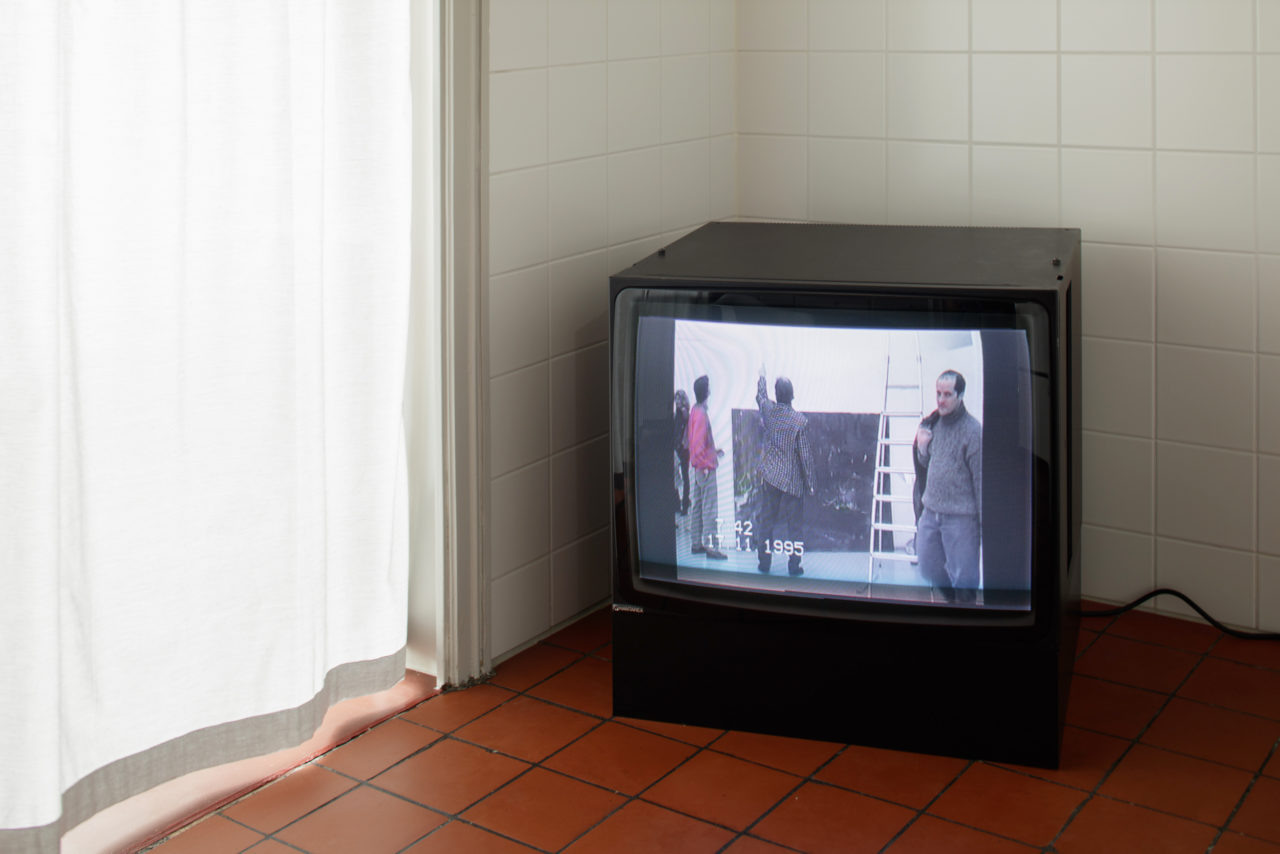
Der strenge Kurator, 1995
Installation view
List of works
Michael Asher
Michael Asher (publication, Santa Monica Museum of Art, Los Angeles, 2008), 2008
Michael Asher
George Washington at The Art Institute of Chicago, 1979 and 2005 (publication, The Art Institute of Chicago, Chicago, 2005), 2005
Michael Asher
Michael Asher (publication, Le Consortium, Dijon, 1992), 1992
Michael Asher
The Michael Asher lobby (table card, The Museum of Contemporary Art Los Angeles, Los Angeles, 1983), 1983
Michael Asher
Writings 1973 – 1983 on works 1969 – 1979 (publication, The press of the Nova Scotia College of Art and Design, Halifax & The Museum of Contemporary Art Los Angeles, Los Angeles, 1983), 1983
Michael Asher
Mein Beitrag für Westkunst (poster, Messe Köln, Cologne, 1981), 1981
Robert Barry
Invitation piece, 1972 – 1973
courtesy Monk Family Collection, Berlin
Robert Barry
Closed gallery (invitation card, Art & Project, Amsterdam, 1969), 1969
Robert Barry
Closed gallery (invitation card, Galleria Sperone, Turin, 1969), 1969
Stanley Brouwn
Stanley Brouwn (invitation card, Institut d’art contemporain, Villeurbanne, 2012), 2012
Stanley Brouwn
Stanley Brouwn (poster, haubrokshows, Berlin, 2012), 2012
Stanley Brouwn
One Eindhoven foot of rope, 2005
Stanley Brouwn
One Eindhoven foot of rope (receipt), 2005
Stanley Brouwn
Durch kosmische Strahlen gehen (booklet, Städtisches Museum Mönchengladbach, Mönchengladbach, 1970), 1970
Stanley Brouwn
Durch kosmische Strahlen gehen (poster, Städtisches Museum Mönchengladbach, Mönchengladbach, 1970), 1970
Martin Creed
The lights off (invitation card, haubrokshows, Berlin, 2006), 2006
Zdenek Felix (Pub.)
Pläne und Projekte als Kunst (publication, Kunsthalle Bern, Bern, 1969), 1969
Günther Förg, Wade Guyton & Jonathan Monk
No visits allowed (poster, haubrok foundation, Berlin 2020), 2020
Florence Jung
Jung52 (letter from Elena Filipovic, Kunsthalle Basel, Basel, 2017), 2017
Michael Krebber
Dan Graham Interview Noema (four photocopies in brochure sleeves, remnant of the display case exhibition by Michael Krebber, Galerie Christian Nagel, Cologne, 1990), 1990
David Lamelas
Publication (publication, Kunstverein München, Munich & Witte de with, Rotterdam, 1997), 1997
Les Levine
Drawings (poster, Fischbach Gallery, New York, year unknown), year unknown
Lucy Lippard (Pub.)
955,000 (publication, the Vancouver Art Gallery, Vancouver, 1970), 1970
Park McArthur
Kunsthalle_Guests Gaeste.Netz.5456 (invitation card, Kunsthalle Bern, Bern 2020), 2020
Jonathan Monk
Continuous project altered daily (booklet, ICA Institute of Contemporary Arts, London, 2005), 2005
Jan Mot (Pub.)
Newspaper Jan Mot 230 (publication, Jan Mot, Brüssel, 2020), 2020
Hans Ulrich Obrist (Pub.)
Hôtel Carlton Palace Chambre 763 (publication, Hans Ulrich Obrist, Paris, 1993), 1993
Mathias Poledna & Christopher Williams
Mathias Poledna Christopher Williams (publication, Bonner Kunstverein, Bonn, 2009), 2009
Klaus Rinke
Aufruf (Text und Hammer), 1969
Karin Sander
Exhibition record, 2016 (excerpt)
courtesy Jörg Johnen, Berlin
Barbara Schmidt Heins
Idee für ein Buch (cover letter, Barbara Schmidt Heins, Pinneberg, 1973), 1973
Barbara Schmidt Heins
Idee für ein Buch (artist list, Barbara Schmidt Heins, Pinneberg, 1973), 1973
Seth Siegelaub (Pub.)
18 Paris IV. 70 (publication, Seth Siegelaub, New York, 1970), 1970
Ricardo Valentim
An exhibition in a business card page, 2017
courtesy Maximilian Hagemes Collection, Luxembourg
Jan van der Marck (Pub.)
Art by telephone (record, MCA Museum of Contemporary Art, Chicago, 1969), 1969
Jan van der Marck (pub.)
Art by telephone (record sleeve, MCA Museum of Contemporary Art, Chicago, 1969), 1969
Franz West & Hans Weigand
Der strenge Kurator – Otto Kobalek kuratiert die Ausstellung Sammlung West, 1995
Christopher Williams
Supplements models prototypes (list of works, ETH Zürich, Zurich, 2017), 2017
Christopher Williams
Programm. Wir nennen es Ludwig. Das Museum wird 40! / We call it Ludwig. The Museum is turning 40! (publication, Museum Ludwig, Cologne, 2016), 2016 (excerpt)
Christopher Williams
Wall from the exhibition „Mathias Poledna / Christopher Williams“, 7 February – 26 April, 2009, Bonner Kunstverein, Bonn, plywood, metal, woodland ink on PVC-free wallpaper, 350 × 350 × 57 cm courtesy Bonner Kunstverein, Bonn, wallpaper printed and installed by omni color, London, Düsseldorf Studio Rhein Verlag, Düsseldorf August 20, 2016 (recto), 2016
Christopher Williams
Wall from haubrok foundation, Berlin, constructed to the artists’ specifications for the exhibition Christopher Williams, 29 April – 15 July, 2007, haubrokshows, Berlin, deconstructed by Dylan Peirce, aluminium, plasterboard, screws, paint, 400.5 × 488.3 × 59.6 cm, haubrok collection, Berlin (documentation, haubrokshows, Berlin, 2007), 2007
Ian Wilson
Discussioni individuali (invitation card, Galleria Massimo Minini, Brescia, 2018), 2018
Ian Wilson
The bliss of the absolute / a discussion. Ian Wilson at Jan Mot (invitation card, Jan Mot, Brussels, 2018), 2018
Ian Wilson
The pure awareness of the absolute / a discussion. Ian Wilson at KW Institute for Contemporary Art (invitation card, KW Institute for Contemporary Art, Berlin, 2017), 2017
Ian Wilson
The pure awareness of the absolute / a discussion. Ian Wilson at Tate Modern (invitation card, Tate Modern, London, 2017), 2017
Ian Wilson
The pure awareness of the absolute: Discussions. Ian Wilson at Dia:Beacon (invitation card, Dia:Beacon, Beacon, 2013), 2013
Ian Wilson
The pure awareness of the absolute in art / a discussion. Ian Wilson at the Haubrok Collection (invitation card, Haubrok Collection, Berlin, 2013), 2013
Ian Wilson
The pure awareness of the absolute in art / discussions. Ian Wilson at Jan Mot (invitation card, Jan Mot, Brussels, 2013), 2013
Ian Wilson
There was a discussion, in Berlin, on the 28th of April, 2013. (certificate, haubrok foundation, Berlin, 2013), 2013
Ian Wilson
The formless absolute: Discussions / Ian Wilson at Art Unlimited, Art 41 Basel (invitation card, Art Unlimited, Basel, 2010), 2010
Ian Wilson
A discussion / Ian Wilson at Museion (invitation card, Museion, Bolzano, 2008), 2008
Ian Wilson
June 1, 2 and 3, 1976, Ian Wilson will be at the John Weber Gallery for discussion (invitation card, John Weber Gallery, London, 1976), 1976
Ian Wilson
March 11, 12 and 13, 1978, Ian Wilson will be in Basel for discussion. (invitation card, Rolf Preisig, Basel, 1976), 1976
Ian Wilson
May 2nd through 4th 1976 Ian Wilson will be in Basel for discussion. (invitation card, Rolf Preisig, Basel, 1976), 1976
Ian Wilson
On the 20th of September 1974 Ian Wilson will be present for discussion from 7 p.m. to 10 p.m. (invitation card, Rolf Preisig, Basel, 1974), 1974
Ian Wilson
On the 22nd of March 1974 Ian Wilson will be at Toselli Gallery for discussion. (invitation card, Galleria Toselli, Milan, 1974), 1974
Ian Wilson
On the 29th of May 1974 Ian Wilson will be in the John Weber Gallery for discussion from 5 p.m. to 8 p.m. (invitation card, John Weber Gallery, London, 1974), 1974
In Wilson
At 8:00 p.m. Ian Wilson will be present for discussion. (invitation card, John Weber Gallery & Gian Enzo Sperone, New York, 1973), 1973
Ian Wilson
On Monday the 28th of March, Ian Wilson will discuss a topic to be announced in the Jack Wendler Gallery, 164 North Gower Street, London n.w.l at 5:00 p.m. (invitation card, Jack Wendler Gallery, London, 1973), 1973
Ian Wilson
Can something be „made“ clear? (invitation card, John Weber Gallery, New York, 1972), 1972
Ian Wilson
Ian Wilson (invitation card, Galleria Toselli, Milan, 1972), 1972
Ian Wilson
Ian Wilson (invitation card, Jack Wendler Gallery, London, 1972), 1972
Ian Wilson
Ian Wilson ist da (invitation card, Konrad Fischer, Düsseldorf, 1972), 1972
